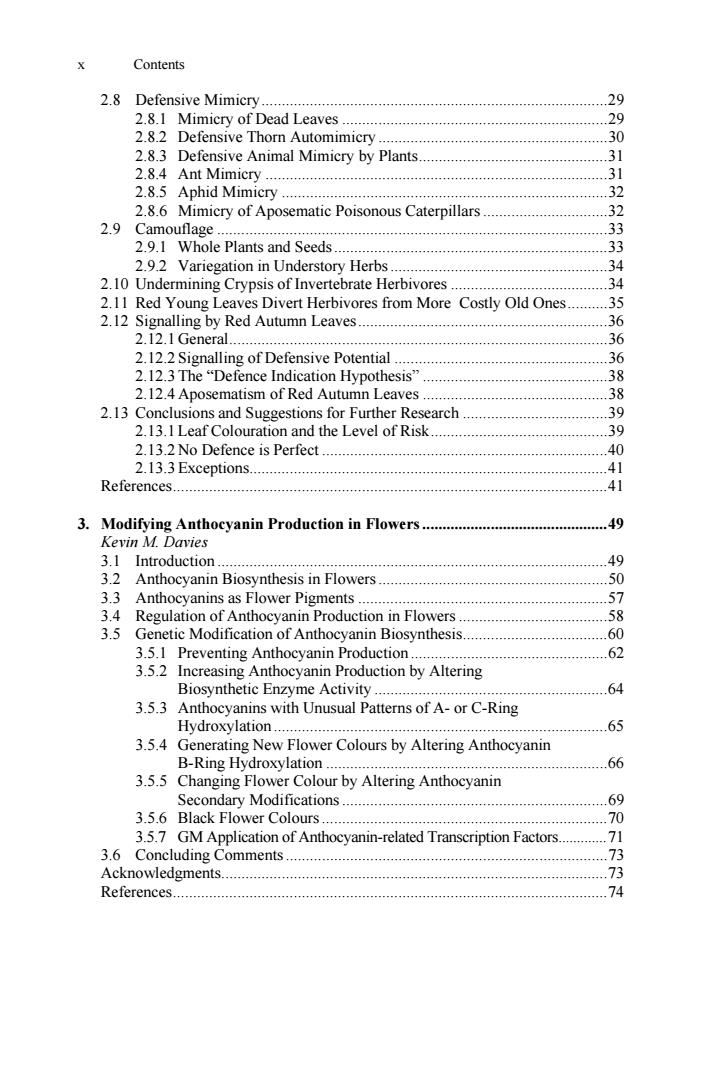正在加载图片...

Contents 2.8 Defensive Mimicry. 39 2.8.1 Mimicry of Dead Leaves.. .29 2.8.2 Defensive Thorn Automimicry 2.8.3 Defensive Animal Mimicry by Plants 31 2.8.4 Ant Mimicry.. 31 2.8.5 Aphid Mimicry 32 2.8.6 Mimicry of Aposematic Poisonous Caterpillars 32 2.9 Camouflage 33 2 9 1 Whole Plants and Seeds 33 2 9 2 variegation in Understory herbs 34 2.10 Undermining Crypsis of Invertebrate Herbivores 34 2.11 Red Young Leaves Divert Herbivores from More Costly Old Ones. 2.12 Signalling by Red Autumn Leaves 36 2 12 I General 36 2 12 2 Signalling of Defensive potential 16 2.12.3 The "Defence Indication Hypothesis" 2.12.4 Aposematism of Red Autumn Leaves 18 2.13 Conclus and Su for Further Research 10 2 13.1Leaf Coloura n and the level of risk 20 2 13.2No Defer ce is Perfec Ref rences 3.Modifyi .49 oductior .3 49 Anthocyanin Biosynthesis in Flowers Anthocyanins as Flower Pigments Regulation of Anthocyanin Production in Flowers Genetic Modification of Anthocyanin Biosynthesis.. .60 3.5.1 Preventing Anthocyanin Production. .62 3.5.2 Increasing Anthocyanin Production by Altering Biosynthetic Enzyme Activity... .6d 3.5.3 Anthocyanins with Unusual Patterns of A-or C-Ring Hvdroxvlation.. .65 3.5.4 Generating New Flower Colours by Altering Anthocyanin B-Ring Hydroxylation 66 3.5.5 Changing Flower Colour by Altering Anthocyanin Secondary Modifications. 69 3.5.6 Black Flower Colours. 70 3.5.7 GM Application of Anthocyanin-related Transcription Factors. 71 3.6 Concluding Comments 73 Acknowledgments.. 73 References. 74 x Contents 2.8 Defensive Mimicry......................................................................................29 2.8.1 Mimicry of Dead Leaves ..................................................................29 2.8.2 Defensive Thorn Automimicry .........................................................30 2.8.3 Defensive Animal Mimicry by Plants...............................................31 2.8.4 Ant Mimicry .....................................................................................31 2.8.5 Aphid Mimicry .................................................................................32 2.8.6 Mimicry of Aposematic Poisonous Caterpillars ...............................32 2.9 Camouflage .................................................................................................33 2.9.1 Whole Plants and Seeds....................................................................33 2.9.2 Variegation in Understory Herbs ......................................................34 2.10 Undermining Crypsis of Invertebrate Herbivores .......................................34 2.11 Red Young Leaves Divert Herbivores from More Costly Old Ones..........35 2.12 Signalling by Red Autumn Leaves..............................................................36 2.12.1 General..............................................................................................36 2.12.2 Signalling of Defensive Potential .....................................................36 2.12.3 The “Defence Indication Hypothesis” ..............................................38 2.12.4 Aposematism of Red Autumn Leaves ..............................................38 2.13 Conclusions and Suggestions for Further Research ....................................39 2.13.1 Leaf Colouration and the Level of Risk............................................39 2.13.2 No Defence is Perfect .......................................................................40 2.13.3 Exceptions.........................................................................................41 References............................................................................................................41 3. Modifying Anthocyanin Production in Flowers ..............................................49 Kevin M. Davies 3.1 Introduction .................................................................................................49 3.2 Anthocyanin Biosynthesis in Flowers .........................................................50 3.3 Anthocyanins as Flower Pigments ..............................................................57 3.4 Regulation of Anthocyanin Production in Flowers .....................................58 3.5 Genetic Modification of Anthocyanin Biosynthesis....................................60 3.5.1 Preventing Anthocyanin Production .................................................62 3.5.2 Increasing Anthocyanin Production by Altering Biosynthetic Enzyme Activity ..........................................................64 3.5.3 Anthocyanins with Unusual Patterns of A- or C-Ring Hydroxylation ...................................................................................65 3.5.4 Generating New Flower Colours by Altering Anthocyanin B-Ring Hydroxylation ......................................................................66 3.5.5 Changing Flower Colour by Altering Anthocyanin Secondary Modifications ..................................................................69 3.5.6 Black Flower Colours .......................................................................70 3.5.7 GM Application of Anthocyanin-related Transcription Factors.............71 3.6 Concluding Comments ................................................................................73 Acknowledgments................................................................................................73 References............................................................................................................74